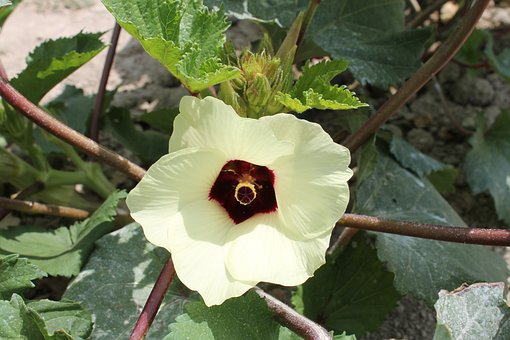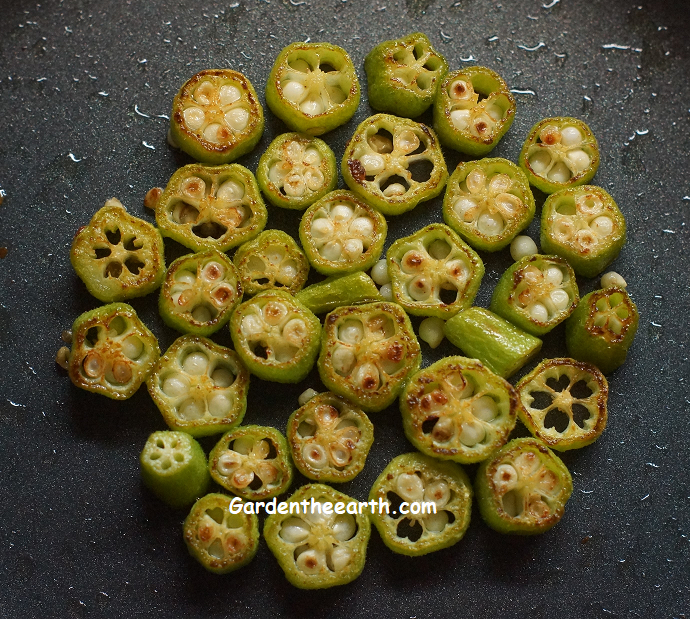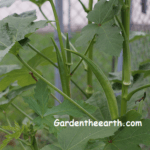Okra Plant Grow Harvest Okra
Grow Okra and you will harvest a unique veggie you can eat right off the plant or use to cook in many different ways. It’s a mixture of flavor and texture unmatched by any other. Harvest okra and use for thickening soups and stews, stewing, canning, frying, roasting, pickling.

What does spineless okra mean?
Some varieties of okra have pods that grow stiff spines or hairs that stick out from the pod. They are like very thin needles that break off and stick to your skin when you handle the pod. They can be very irritating to some, and not safe for those of us who like to pop a pod off the plant and munch right there.
Spineless varieties have been developed that eliminate the spines from the pods, such as the popular Clemson Spineless 80 Okra Seeds. Out of habit, I still wipe the fuzzy outside of the pod with a towel before eating it.
Best type of soil and site for okra
Okra needs fertile loamy soil, evenly moist but not soggy. It will not do well in soil that has poor drainage. Consider amending soil with several inches of aged compost or organic matter before planting.
Okra loves consistent full sun and warmth. They don’t care for abrupt changes such as cool temperatures or extended shady conditions.
Planting and growing okra
Okra can be transplanted or direct seeded.
Okra is a warm weather lover, so this is a good plant to consider for starting indoors to get a jump on the maturity date. Start plants 4-5 weeks before desired outdoor planting date.
Okra needs warm soil to germinate, so direct sow seeds when the ground gets to about 68 degrees. If seeds are planted too soon, they may just deteriorate in the ground waiting for the soil temperature to warm up.
Okra seedlings look spindly at first, with large leaves at the top that appear to overpower the stem. But don’t underestimate their capability to develop quite quickly into strong substantial plants.
Keep the plants mulched and soil moist for best production. Okra can tolerate moderate dry spells, but extended spells will affect growth of the plant and pod production. Regular watering and fertilizing will promote abundant harvest.
Annie Oakley Okra – Spineless pods on compact plants that grow 4-5 feet.
Clemson Spineless Okra – Grows to 6 feet tall, producing pods as it grows in height. Pods can grow 7-8” long but are most reliable at 3-6”.
Dwarf Green Long Pod Okra – If you prefer a shorter plant, this dwarf spineless variety grows to two feet tall. Produces high yields of 8” long pods.
Emerald Green Velvet Okra – Spineless pods to 7” long on two foot tall plants
Harvesting okra
While spineless varieties of okra pods have been developed, the plant stems and leaves still have spines. These needle-like spines can break off and be really irritating to skin. If you need to rub against any part of the plant to harvest the pods, protect your skin. If you get stuck by a few, press a wide piece of tape to the area and remove. Sometimes I am able to remove them with this method.
Pods are ideally cut at 3 – 6” long, and can become woody. I find that the pods that get tough tend to be the ones that have been on the plant longer – not necessarily just because the pod is large. Larger pods can be tender too.
Harvest by cutting the pod off at the stem that attaches to the main plant. Use sharp cutters because it’s a short strong stem. It can be a tight area to maneuver in. If using scissors, be careful not to insert them too far so you don’t clip a stem on the other side too.
Remove pods that are mis-shaped such as growing round but not long, or the seeds bulging inside. Pods left to mature will reduce production. Check the plants daily and keep removing the pods to encourage formation of new ones.
To keep cut okra fresh store in the fridge or freeze. If left at room temperature they get soft within a day.
Did you know? Okra is a great source of calcium, providing 82 mg per cup raw.
See these other Calcium Rich Vegetables you can grow in your own garden.
Cooking Okra

My favorite way to cook okra is to slice it and fry it in butter. To eliminate the slime, get the butter very hot first. Lay the sliced okra cut side down into the butter to sear the cut edge, then quickly flip over to sear the other side. Now the okra is “sealed” and will not get slimy. Brown as desired and enjoy. There’s never leftovers of these!
What to do with Okra in the fall
Dried Pods – Late in the season, allow pods at the top of the plant to mature until dry. These pods are useful for dried flower arrangements or fall decorations.
Compost – Tall mature okra plants have substantial woody stems. Chop into small pieces and use in the compost pile.

